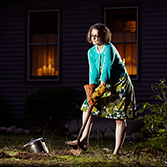Tete-a-tete Archives
An eclectic sampling of my award-winning humor columns. New columns can be read online at www.nashuatelegraph.com on the first Thursday of the month, with columns posted here later in the month.More in "Tete-a-tete"
- Tete-a-tete: Pop culture references lead to unexpected connections
- Tete-a-tete: "Handicapped accessible" doesn't really mean what people think it means
- Tete-a-tete: The ins and outs of the college moving experience
- Tete-a-tete: When dealing with cabin fever, this cat's on a roll
- Tete-a-tete: An artistic masterpiece 20 years in the making
- Tete-a-tete: Promp and circumstance: Modern-day prom prep
- Tete-a-tete: Blue Apron - a Pandora's box of weekly culinary adventures
- Tete-a-tete: Serve up a slice of family traditions, new or old
- Tete-a-tete: 'Family court' has a whole new meaning at our house
- Tete-a-tete: Drafted on the farm: Grandpa's war at home
- Tete-a-tete: With family, you have to give it the ol' college try
- Tete-a-tete: Walk a mile in my Boots: Viva la feline difference
- Tete-a-tete: Slacker movies offer unlikely heroes
- Tete-a-tete - Bag that theory: Purse contents aren't all that enlightening
- Tete-a-tete: Keeping up with the pace of modern-day elder care
- Tete-a-tete: Easter dinner reveals a shocking family secret
- Tete-a-tete: Time flies when you forget to change the clocks
- Tete-a-tete: Here in New Hampshire, we don't take voting 'for granite'
- Tete-a-tete: An Eagle takes flight in another family milestone
- Tete-a-tete: When choosing heirlooms, cross your Ts and dot your ... claims
- Tete-a-tete: Even the best-intentioned Christmas traditions can fail to take hold
- Tete-a-tete: How to enjoy a wedding, even if it's not your own
- Tete-a-tete: A tale of unintentional cat ownership
- Tete-a-tete: Admissions about the college admissions process
- Tete-a-tete: Avoiding car-tastrophe while purchasing a new vehicle
- Tete-a-tete: As American as apple pie: U.S. culture, through other eyes
- Tete-a-tete: The geek gene runs strong in our family
- Tete-a-tete: Grieving entertainment losses with a few simple steps
- Tete-a-tete: Parents, do not give your child the name equivalent of the April birthstone
- Tete-a-tete: Memento or clutter? Don't leave that decision to the historians
- Tete-a-tete: How Mom and Dad saved Christmas (and a hamster)
- Tete-a-tete: Having trouble keeping your New Year's resolutions? It could be "If You Give a Mouse a Cookie" Syndrome
- Tete-a-tete: When Christmas starts before Thanksgiving (a reflection on temporal discombobulation)
- Tete-a-tete: Sizing up a new family pet, or the difference between a cat and a hamster
- Tete-a-tete: When your worst fear comes true
- Tete-a-tete: Family game night can leave you drawing a blank
- Tete-a-tete: When you have a really good reason to skip class
- Tete-a-tete: The downside to the world's most flattering bridesmaid dress
- Tete-a-tete: Say it with flowers - just don't say where you got them
- Tete-a-tete: Shockingly true tales of my Herculean, heroic great-grandpa
- Tete-a-tete: For goodness 'sakes - generational namesakes can confuse
- Tete-a-tete: Confused by the weather? Signs spring has almost sprung
- Tete-a-tete: Seeking the Holy Grail of a universal bridesmaid dress
- Tete-a-tete: Love poetry gone bad, or why I'm still not allowed to use matches
- Tete-a-tete: A traveler's guide to the Big Apple
- Tete-a-tete: Feats of strength aren't just for Festivus festivities
- Tete-a-tete: Change comes from within - sometimes, literally
- Tete-a-tete: Car games: from punch-buggy to punching cell phone buttons
- Tete-a-tete: I mustache you a question about costume practicality
- Tete-a-tete: Functional furniture is making my family dysfunctional
- Tete-a-tete: Jungle Speed board game can bring out the beast in you
- Tete-a-tete: To call it a ‘mooving’ ride would be inaccurate
- Tete-a-tete: When saying ‘sweetheart’ just won’t do
- Tete-a-tete: Eat your heart out, Festivus: Stymchastynchula is here
- Tete-a-tete: Hoping Korean music can explode in the U.S. with a K-pop
- Tete-a-tete: Holidays, especially with Grandma, are always colorful
- Tete-a-tete: Sometimes, it's the grilled cheese that makes the memories
- Tete-a-tete: Still recovering from Dad's forays into home education
Tete-a-tete: “Handicapped accessible” doesn’t really mean what people think it means
Given the widespread access to information in this day and age, it’s easy to assume we’re all on the same page regarding the definition of certain phrases. If you don’t understand what something means, you can Google it, you can ask Siri about it or, if you’re a bit more old-school, you can look it up in a dictionary or an encyclopedia.
Take, for example, the phrase “handicapped accessible.” Wiktionary defines this term as an adjective that describes something that is “able to be accessed by people having physical handicaps.”
In practice, however, the definition of “handicapped accessible” appears to be “What? We made the space a little bigger and put some grab bars on the walls. What do you mean you’re still having problems?”
Over the course of the past year, my 92-year-old grandfather’s health has steadily declined. He’s completely there mentally and in good spirits, but his condition is such that he’s now on oxygen 24/7 and needs a wheelchair to get around.
Mom and I have been facilitating Grandpa’s travels, which have ranged from medical appointments where he lives in upstate New York to a multi-day road trip down to Georgia to attend his last sales convention for the company for which he worked for half a century. Our experiences have run the gamut from mildly inconvenient to “Is there a hidden camera somewhere? Are we being pranked?”
I’d like to acknowledge here that the language surrounding physical disabilities and mobility issues can be very charged and that everyone has their preferred vocabulary for describing these particular challenges. I’ve opted to use the term “handicapped accessible” because that’s how the managers and other personnel with whom we interact usually describe their facilities.
The biggest offenders, I’ve discovered, are bathrooms. Contrary to the opinion of most designers, a slightly bigger space and grab bars on the wall near the toilet does not a handicapped-accessible restroom make.
More often than not, we have to soap up Grandpa’s hands for him because the soap dispenser is too high or too far away for him to reach. We then have to splash water onto his hands to rinse them because the sink is so high that he can’t turn on the faucet himself, much less stretch his arms far enough to get his hands under the flow of water.
Paper towel dispensers and trash cans tend to be similarly out of reach. We have better luck with hand dryers, but if they’re not automatic, someone may still need to push the button for him because the dryer is positioned too high. Mom always carries hand sanitizer in the event we end up in a hand-washing scenario that’s going to be too taxing for Grandpa.
In addition to the height and positioning of the fixtures, the size of the bathroom can also be an issue. It doesn’t matter if the bathroom’s bigger if it’s not big enough to get a wheelchair inside and then maneuver the wheelchair within the bathroom space (see also: elevators). This may seem like an unnecessarily obvious statement, but Grandpa and I had a close call where I was able to get him into the restroom but almost couldn’t get him out again.
That bathroom, by the way, happened to be in a brand-new hospital, where you would think accessible design would have been a priority. Don’t get me started on the contortions required to fit a wheelchair into the examination rooms and then position said wheelchair in range of the room’s oxygen hookup.
On a related note, I’ve been in more men’s bathrooms these past few months than I care to count, a fact that Grandpa and his twin brother find quite entertaining. You do what you need to do to help your loved ones. And I always knock first.
Hotel rooms are another area where the meaning of “handicapped accessible” becomes ambiguous. Turning on the lights upon entering a handicapped-accessible room can be unexpectedly tricky. Sometimes, the light switch on the wall was mounted too high for Grandpa to reach while sitting in his wheelchair.
In one room, the wall switch didn’t turn on the lights at all because the previous occupant had turned off all the lamps by hand before leaving. To sync the lamps back up with the switch, we had to turn all of them on by hand – including a floor lamp wedged in a corner behind a table – and flip the switch off and then on again.
Had Grandpa been there by himself, he would have had to sit in the dark until there was enough sunlight for him to see by. Except that there was no way he would’ve been able to open the shades on his own.
Speaking of hotels, their definition of handicapped-accessible parking can also leave something to be desired. One particular hotel had rooms that opened onto the exterior of the building, and Mom and I were very excited that there was a handicapped-accessible parking spot right in front of Grandpa’s room. After hours of driving, it would be great to get him right inside so he could relax.
Unfortunately, though the parking spot had a sign indicating it was handicapped accessible, the sidewalk didn’t have a point of entry for a wheelchair. While Mom and I were working on a solution, Grandpa and his twin took matters into their own hands.
Grandpa’s twin, who is a bit unsteady and often pushes Grandpa’s wheelchair instead of using a walker, pushed him all the way across the parking lot to the other end of the hotel to get him up onto the sidewalk and then pushed him all the way back down the sidewalk to get to his room. So much for easy access.
Regardless of where your travels may take you, you will eventually have to deal with the dreaded “lip.” Those of you who have maneuvered wheelchairs may already be nodding and cringing.
Most entrances have a slightly raised part of the doorframe you have to step over in order to enter the building. It’s a subtle bump you may not even notice if you can walk easily. To an inexperienced wheelchair jockey, it feels like you’ve suddenly run up against the Great Wall of China.
There’s a knack to successfully navigating a wheelchair over a lip and, as Grandpa can tell you, I’m still mastering it. You have to push down on the wheelchair handles and pop the front wheels up and over the lip. If you try to meet the lip head-on and push the wheelchair straight over it, substituting force for finesse, you run the risk of accidentally dumping your passenger head-first onto the floor.
I have yet to unintentionally eject Grandpa, but we’ve had a few rocky encounters with the lip, the most memorable being at a restaurant with a 45-degree ramp leading up to its entryway. Pushing my 165-pound grandfather and his oxygen tank up the ramp was enough of a challenge – and then we ran into the lip right at the top.
I couldn’t go backward without risking a Three Stooges scenario, and I didn’t have enough stamina left to execute the required wheelie. I’d love to tell you how I managed it, but I don’t quite remember. It’s possible I blacked out and had an Incredible Hulk moment.
For those of us who are able-bodied and accustomed to navigating our environment without a second thought, it often takes a mobility impairment – either of our own or of someone we know – to realize that “handicapped accessible” tends to mean limited or incomplete accessibility. Great strides have indeed been made, but there is certainly room for improvement.
Perhaps we can require that anyone who designs a handicapped-accessible space must successfully navigate it with a mobility aid before it’s approved for public use. Soap dispensers might suddenly be easier to reach if a few architects had to deal with dirty hands sans the benefit of a savvy caregiver with hand sanitizer.
– Teresa Santoski
Originally published July 6, 2017
Browse the compendium
Compendium (noun): a summary or abridgment.
Click the icons to the right to check out a sampling of my work.




